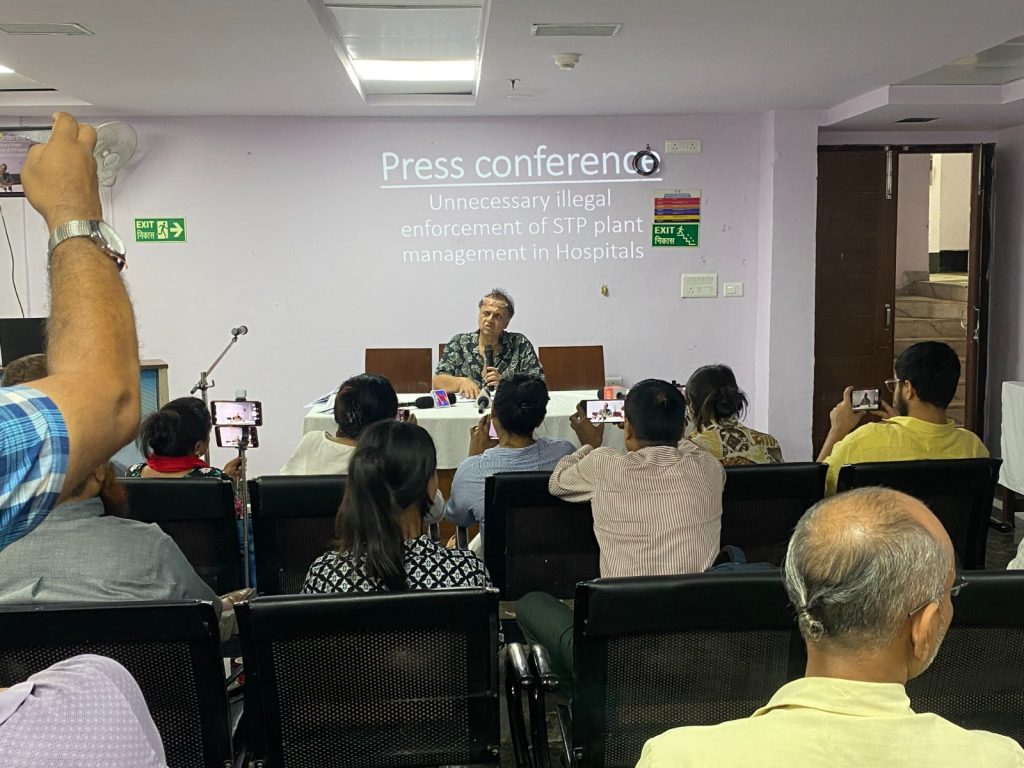In the bustling heart of New Delhi, where the chaos of urban life meets the sanctity of healthcare, a storm was brewing. Dr. Prem Agarwal, chairman of Sanjeevan Hospital and president of both the National Medical Forum and the Delhi Hospital Forum, stood at the forefront of a critical issue threatening the city’s hospitals. The Central Pollution Control Board (CPCB) and local authorities were imposing what Dr. Agarwal called an “unorganized and unnecessary” mandate: forcing hospitals to install and manage their own Sewage Treatment Plants (STPs). This directive, he argued, was not just redundant but posed risks to hospital management, doctors, and healthcare workers, while straining already stretched resources.

Dr. Prem Agarwal, Addressing Press Conference
The CPCB, established under the Water (Prevention and Control of Pollution) Act, 1974, is India’s apex body for regulating pollution. It sets guidelines to ensure environmental compliance, including the treatment of sewage and biomedical waste from industries and institutions like hospitals. According to the CPCB’s 2016 guidelines, centralized STP systems—large-scale facilities designed to treat sewage from multiple sources—are sufficient for managing hospital wastewater. These systems treat and recycle water, ensuring it meets environmental standards before being released or reused. Delhi, with its network of centralized STPs managed by the Delhi Jal Board, had been effectively handling hospital sewage under this framework.
Yet, in a perplexing turn of events, hospitals across the capital were now being coerced into installing individual STPs on their premises. Dr. Agarwal saw this as a bureaucratic overreach. “The existing centralized STP systems are robust and efficient,” he declared at a recent press conference. “Forcing hospitals to set up their own STPs is not only duplicative but also places an undue financial and technical burden on healthcare institutions.” He explained that the installation, maintenance, and operation of STPs require specialized expertise, costly equipment, and continuous monitoring—resources that small and medium-sized hospitals, in particular, could ill afford.
The implications were dire. Hospitals, already grappling with the demands of patient care, faced the risk of diverting funds from critical services like emergency care, diagnostic equipment, or staff training to comply with this mandate. Dr. Agarwal highlighted a chilling concern: the improper handling of STPs could compromise the safety of doctors, nurses, and other healthcare workers. Mishandled sewage systems could lead to contamination, biohazards, or even infections, undermining the very purpose of hospitals as sanctuaries of healing.
Dr. Agarwal’s frustration was palpable as he recounted the case of a small hospital in East Delhi. With only 50 beds and a lean budget, the hospital was struggling to comply with the new STP directive. “They’re being forced to choose between upgrading their ICU or installing an STP they don’t need,” he said, shaking his head. “This is not just about money—it’s about the quality of care we can provide to our patients.”
The doctor’s crusade wasn’t just about resisting an impractical policy; it was about protecting the healthcare ecosystem. He argued that the centralized STP system, if strengthened, could handle the city’s needs more efficiently. These facilities, often equipped with advanced technologies like Moving Bed Biofilm Reactor (MBBR) or Sequential Batch Reactor (SBR), are designed to treat large volumes of sewage with consistent monitoring by trained professionals. In contrast, individual hospital STPs, especially in smaller setups, risked being under-maintained due to lack of expertise or funding, potentially leading to environmental violations—the very issue the CPCB aimed to prevent.
Dr. Agarwal’s demands were clear and resolute. He called upon the Lieutenant Governor of Delhi to intervene urgently and address the crisis. His three-point agenda was a clarion call for reason:
Exempt hospitals connected to centralized STPs from the obligation to install individual systems, recognizing the efficiency of the existing infrastructure.
Strengthen Delhi’s centralized STP network, investing in upgrades to ensure it could handle the city’s growing healthcare demands without compromising environmental standards.
Relieve hospitals of unnecessary financial and technical burdens, allowing them to focus on their primary mission: saving lives.
As Dr. Agarwal stood before a room of reporters, his voice carried the weight of conviction. “Hospitals are not factories. Our job is to heal, not to wrestle with redundant regulations,” he said. His words resonated with hospital administrators across Delhi, many of whom had privately voiced similar concerns but lacked the platform to challenge the status quo.
The issue sparked a broader debate. Environmentalists argued that hospitals, as significant generators of biomedical waste, must be held to strict standards. However, they also acknowledged that centralized systems, when well-maintained, were often more reliable than fragmented, hospital-specific solutions. The CPCB, for its part, remained silent on the controversy, leaving hospitals in limbo as they awaited clarity.
In the quiet corridors of Sanjeevan Hospital, Dr. Agarwal continued his work, tending to patients while preparing for the next phase of his advocacy. He knew the fight was far from over, but he was determined to ensure that reason prevailed. For him, this was more than a policy dispute—it was a matter of principle, a stand for the sanctity of healthcare in a city that desperately needed it.
As the sun set over Delhi, casting long shadows across the capital’s hospitals, Dr. Agarwal’s demands echoed in the minds of those who heard him. Would the authorities listen? Would the burden on hospitals be lifted? Only time would tell, but one thing was certain: Dr. Prem Agarwal would not back down.

